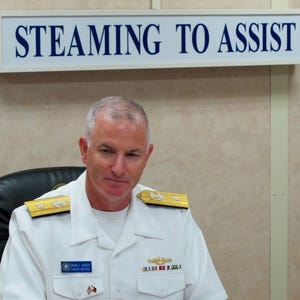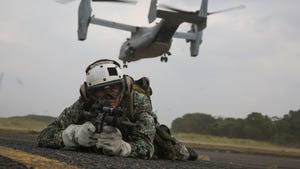As the U.S. launches Operation Odyssey Lightning against the Islamic State group in Libya, a fourth front in the war against the brutal militant group, U.S. commanders are casting a wary eye on a possible fifth front: the Asia-Pacific.
The U.S. is launching strikes in Syria, Iraq, Afghanistan and now Libya, but military leaders and strategists are alarmed by waves of violence and signs that countries with large Muslim populations like the Philippines and Bangladesh could be ISIS’s next global stronghold.
In a July 27 speech to the Rebuild Japan Initiative Foundation, U.S. Pacific Command head Adm. Harry Harris said the region would need to work together to stop ISIS from metastasizing into what the U.S. military calls the Indo-Asia-Pacific region.
“I often talk about the U.S. strategic rebalance to this region,” Harris said. “Regrettably, I believe that ISIL is also trying to rebalance to the Indo-Asia-Pacific. To halt the Islamic State’s cancerous spread in Asia, we can’t work alone. We must work together.
“Thankfully, Japan and many other like-minded nations have joined the counter-ISIL coalition. Together, we can — and will — eradicate this disease.”
On July 2, a group of militants claiming allegiance to ISIS burst into a Bangladeshi restaurant and killed 20 foreign citizens, including an American and seven Japanese. It was the latest in a series of brutal attacks on foreigners and progressives in the country, which has raised the specter of a new wave of violence in the country.
Closer to home, U.S.-ally the Philippines has also seen a surge in violence from extremist groups on the islands of Mindanao, Sulu and Basilan. In May, the militant group Abu Sayyaf, which pledged allegiance to ISIS in 2014, released a video of the beheading of Canadian citizen John Ridsdel, which was followed by a beheading video in June of a second Canadian hostage, Robert Hall, after the group did not receive ransom for the men.
Significantly, the threat of ISIS spreading into Bangladesh was the first threat Harris raised in his 20-minute speech.
Special Operations Forces have been combating militant groups in Asia since after Sept. 11, 2001, including the group Abu Sayyaf. In 2009, two Green Berets were killed in a roadside bomb blast on the Philippines’ island of Jolo, in Abu Sayyaf's Sulu Province stronghold. Special operations forces, including Navy SEALs, have also trained with the Indonesian military, which is confronting its own ISIS threat. In January, ISIS claimed responsibility for an attack in Jakarta that killed four civilians and injured 20 others.
Experts say that ISIS is a problem in Asia but not to the extent that it is in Iraq, Syria and Libya
“I would describe the ISIS presence there as limited but significant,” said Thomas Sanderson, an expert on trans-national threats with the Center for Strategic and International Studies think tank. “It is significant because so many fighters have gone to the battlefield in the [Middle East, North Africa] region.”
According to the security firm The Soufan Group, the Philippines and Malaysia have each sent about 100 fighters to fight in Iraq and Syria. Indonesia has about 700 of its citizens there, China has about 300 and even Singapore has a couple of known ISIS fighters.
The main threat comes from fighters returning to their home countries as U.S. and allied forces press on ISIS-claimed territory in their self-declared caliphate that spans between Syria and Iraq, Sanderson said.
“As their revenue and territory shrinks in Syria and Iraq, you could see a wave of fighters going back to the Philippines and Indonesia,” he said, adding that those fighters could train and inspire like-minded people to launch attacks back home.
“That can be greatly destabilizing to governments,” he said.
Sanderson said the U.S. should be proactive to deal with the threat, and called for the government to organize a multinational approach to the problem.
“The U.S. has a huge role in preventing this because it is the lead element in the global struggle against terrorism,” he said.
Harris’s notion that ISIS is pivoting to Asia may be accurate, but isn’t fully realized yet, said retired Adm. James Stavridis, who last served as the NATO's Supreme Allied Commander Europe and who now heads the Fletcher School at Tufts University.
“The ‘pivot’ of the so-called Islamic State to the Indo-Pacific region is aspirational at this point, but we should be alert to their attempts to gain a stronger foothold, particularly in Bangladesh and Indonesia,” Stavridis said.
Stavridis agreed that building partnerships is the way to deal with the problem.
“As always, the keys to combating any terror organization are through building bridges: international coalitions, inter-agency cooperation, private-public engagement, and effective strategic communications,” he said in an email, adding that the military will have to bring its power to bear at times.
“It will require a mix of hard and soft power to effectively confront them,” he said.
In a statement, PACOM spokesman Cmdr. Dave Benham said Harris's use of the term "rebalance" referred to ISIS's physical expansion to Asia but also the expansion of its influence there. Confronting the threat from returning fighters is a multinational effort already underway, Benham said.
"Our partners in the Indo-Asia-Pacific are attuned to the threat posed by foreign terror fighter recruitment and recognize the potential threats to security they face from returning fighters," he said. "U.S. Pacific Command and Special Operations Command Pacific are working with our regional partners to proactively counter this threat."



No comments:
Post a Comment